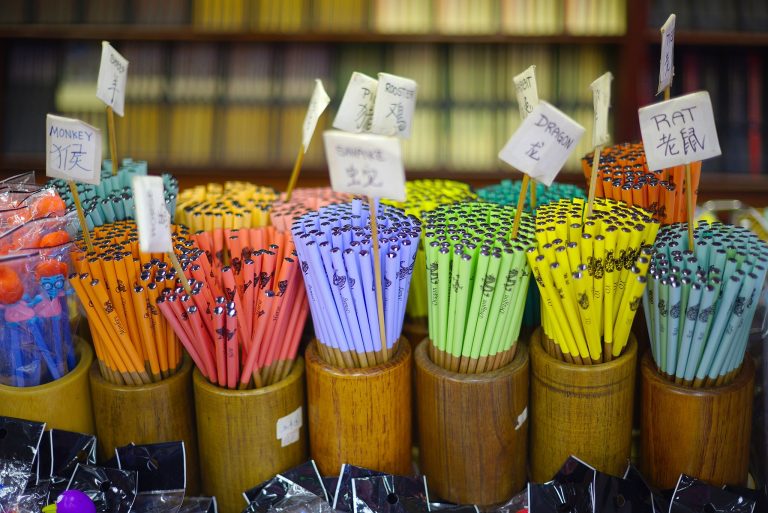The Chinese-invented chopsticks have become one of the world’s most popular and essential eating tools. Statistics estimate over 1.5 billion individuals worldwide use chopsticks daily. They are the most commonly used utensils in four Asian countries; China, Japan, Korea, and Vietnam.
The Eastern spirit is said to be found in every interaction among people. It has been recounted that once while dining at a restaurant in China the host held up a chopstick and asked, “Does this have a spirit?” to which everybody said, “yes.”
Chopsticks “箸” as a cultural symbol
While the earliest known textual mention of chopsticks is from a philosophical document dated 280–233 BC, ancient bone chopsticks from the Neolithic period were discovered in Longqiuzhuang Village, Jiangsu Province, that were over 7,000 years old.
Chinese folklore tells of a time in antiquity when all Chinese people ate with their hands. One legend tells that there was a boy named Kuai (Quick.) He was the youngest of three boys, but he was never quick enough to grab some nourishment before his brothers. In desperation born of hunger, he pulled two sticks from the kindling pile and used them to spear chunks of steamed vegetables. His family members immediately copied the tools and named them Kuai zi (quick ones.)
The Mandarin word for chopsticks is written as 筷子 (kuai zi), which sounds the same as the words 快子, which also means the quick advent of a son. It can also be interpreted as “have a son quickly,” so chopsticks are readily accepted as wedding gifts.
Success
You are now signed up for our newsletter
Success
Check your email to complete sign up
These small and useful Chinese icons are often beautifully painted by artists and then collected the world over. Chopsticks have also been used as fashion accessories, with upper class ladies historically adorning their complex hairstyles with silver or gold chopsticks.

Chopsticks compared with other cutlery
While it is readily understood that the Chinese invented the chopstick, many do not realize that they also invented the fork! Utensils similar to modern forks and knives, often made of bone, have been discovered dating back to around 2000 BC). If both forks and chopsticks were available in ancient China, one might wonder why the chopstick came out on top?
It is likely that the ancient Chinese philosopher Confucius steered Chinese dining customs toward chopsticks, with his outright disdain of knives. The avid vegetarian was quoted as saying, “The honourable and upright man keeps well away from both the slaughterhouse and the kitchen. And he allows no knives on his table.” Thus, Chinese food comes to the table ready to be consumed without any need for “barbaric” cutting.
In examining the merits of cutlery, we find that, if one is skilled with their chopsticks, they can do many things that a fork cannot. Lifting without puncturing is a plus, for one thing; and gripping rather than carrying leaves less room for droppage. In addition, the pinching movement can not only be used to grasp a food, but also to pull it apart. A fork could never be so exacting as to pick up a single grain of rice, but two chopsticks can pick up just about anything small enough to eat.
Wood, bamboo, metal, bone, stone, and compound chopsticks are all types of materials used for chopsticks. Chinese chopsticks are generally long, up to 10 inches. Japanese chopsticks can be as short as 8 inches, while Korean and Vietnamese chopsticks are medium sized. It is customary for Chinese to share a large table of food, and long chopsticks make it simpler to reach.
Using chopsticks
Using chopsticks requires more than 30 joints and 50 muscles in the fingers and wrist, arm, and shoulder, along with thousands of nerves. It is a skill that requires practice, and proper holding technique. If you haven’t already mastered the art of eating with chopsticks, the following video will be helpful.
Although it may not come naturally at first, don’t despair. Remember that Asian children as young as three years old can tackle chopsticks, and you can too. The fear of chopsticks is called “Consecotaleophobia.” Don’t be consecotaleophobic!
Using chopsticks requires focus and brain power, so you could regard this as a worthy educational exercise. Also, eating naturally takes a bit longer when using chopsticks, which usually results in recognizing the feeling of fullness before it is too late, as is often the case when people eat too fast. Thus, chopsticks may help you maintain a healthy weight.
Aside: According to ancient Korean superstition, the closer to the tips one holds one’s chopsticks, the longer one will remain unmarried.
Chinese Etiquette
When invited to a Chinese dinner, it would be good to remember the following rules of etiquette:
- Do not tap your chopsticks on the edge of your bowl (beggars often do this to attract attention).
- Do not make pointing motions with your chopsticks. It is considered as rude as pointing at someone with your finger.
- Do not put chopsticks vertically into a bowl of rice. This resembles incense offerings to the dead and thus has unpleasant connotations.
- When everyone is seated, let the elderly take their chopsticks first. This is a basic sign of respect.
- Leave your chopsticks on top of the bowl when you’re finished, and on the side if you’re taking a break. The host will understand without verbal communication.
When it comes to the dinner table, traditional Chinese children are taught to serve others first by taking food from the communal dishes and putting it on their elders’ plates as a sign of reverence. Consequently, Chinese people do not hesitate to serve others at social dining events, much to the puzzlement of non–Chinese guests.
Heaven and Hell
There is a Chinese folk story about the difference between Heaven and Hell.
In Hell, everyone’s arms are much shorter than normal. They are seated around tables piled high with delectable fare, yet they are miserable because they are unable to get the food into their mouths, since the chopsticks are too long and their arms are too short.
While everyone in Heaven also has short arms and long chopsticks, they are lighthearted, and having a wonderful time at the feast; because they are feeding each other.
Ila Bonczek contributed to this report.














